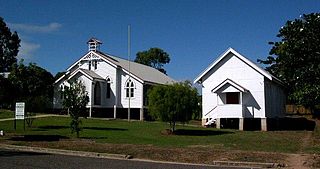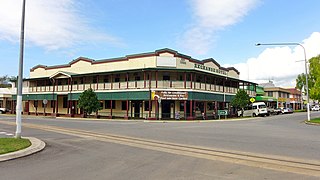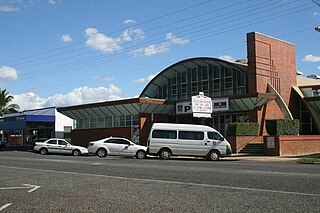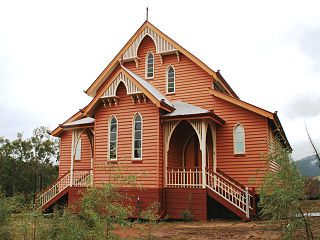
Port Douglas is a coastal town and locality in the Shire of Douglas, Queensland, Australia, approximately 60 km north of Cairns. In the 2021 census, Port Douglas had a population of 3,650 people. The town's population can often double, however, with the influx of tourists during the peak tourism season from May to September. The town is named in honour of a former Premier of Queensland, John Douglas. Port Douglas developed quickly based on the mining industry. Other parts of the area were established with timber cutting in the area surrounding the Daintree River and with settlement starting on lots around the Mossman River by 1880.

Mossman is a rural town and locality in the Shire of Douglas, Queensland, Australia. It is the administrative centre for the Douglas Shire Council In the 2016 census, the locality of Mossman had a population of 1,937 people.

The Roman Catholic Diocese of Cairns is a diocese of the Catholic Church located in the state of Queensland, Australia. It is a suffragan diocese of the Archdiocese of Brisbane. The diocese was erected as a vicariate apostolic in 1877 and was elevated to a diocese in 1941. Its territorial remit is Far North Queensland.

Our Lady Star of the Sea Church & School is a heritage-listed Roman Catholic church and school at Goondoon Street, Gladstone, Gladstone Region, Queensland, Australia. It was built from 1924 to 1950. It was added to the Queensland Heritage Register on 21 October 1992.

St Patrick's Catholic Church is a heritage-listed former Roman Catholic church at 27 Spiller Street, Brandon, Shire of Burdekin, Queensland, Australia. It was built in 1910. It is also known as Burdekin Academy of Dance. It was added to the Queensland Heritage Register on 21 October 1992.

St John's Anglican Church Precinct is a heritage-listed churchyard at 30-34 Macrossan Street, South Townsville, City of Townsville, Queensland, Australia. It was built from c. 1907 to c. 1911. It was added to the Queensland Heritage Register on 21 October 1992.

St Monica's Cathedral is the cathedral of the Catholic Church in the Diocese of Cairns. It is located at 183 Abbott Street, Cairns City, Cairns, Queensland, Australia. The cathedral was designed by Ian Ferrier and built from 1967 to 1968. It was added to the Queensland Heritage Register on 31 August 1998.

St David's Anglican Church is a heritage-listed church at 3 Foxton Avenue, Mossman, Shire of Douglas, Queensland, Australia. It was designed by Edward Taffs and Edwin Roy Orchard. It was added to the Queensland Heritage Register on 6 August 2010.

St Monica's Old Cathedral is a heritage-listed former Roman Catholic cathedral at Minnie Street, Cairns City, Cairns, Cairns Region, Queensland, Australia. It was designed by Lawrence and Lordan and was built in 1927 by Michael Garvey. It is also known as St Monica's Cathedral and St Monica's Church & School. It was added to the Queensland Heritage Register on 1 July 1997.

Bishop's House is a heritage-listed former Roman Catholic monastery and now bishop's residence at Abbott Street, Cairns City, Cairns, Cairns Region, Queensland, Australia. It was designed by Father Joseph Phelan and built in 1930 by Michael Garvey. It is also known as St Monica's Monastery/Priory. It was added to the Queensland Heritage Register on 1 July 1997.

Port Douglas Wharf is a heritage-listed wharf at 6 Dixie Street, Port Douglas, Shire of Douglas, Queensland, Australia. It was built in 1904. It was also known as Shipwreck Museum. It was added to the Queensland Heritage Register on 21 October 1992.

Mossman District Hospital is a heritage-listed public hospital at Johnston Road, Mossman, Shire of Douglas, Queensland, Australia. It was designed by Hill & Taylor and built c. 1930 by J J Riley. It was added to the Queensland Heritage Register on 12 June 2009.

National Bank of Australasia Building is a heritage-listed former bank at 11 Mill Street, Mossman, Shire of Douglas, Queensland, Australia. It was designed by Lange Leopold Powell and built from 1935 to 1936 by Arthur E Zillfleisch and Tom Booth. It was added to the Queensland Heritage Register on 6 August 2010.

Exchange Hotel is a heritage-listed hotel at 2 Front Street, Mossman, Shire of Douglas, Queensland, Australia. It was designed by Vibert McKirdy Brown and built from 1934 to 1935. It was also known as Daintree Inn. It was added to the Queensland Heritage Register on 9 November 2012.

Cooktown Museum is a heritage-listed former convent and school and now museum at Furneaux Street, Cooktown, Shire of Cook, Queensland, Australia. It was designed by Francis Drummond Greville Stanley and built from 1888 to 1889 Hobbs & Carter. It was formerly known as St Mary's Convent and School. It was added to the Queensland Heritage Register on 21 October 1992.

St James Catholic Church is a heritage-listed Roman Catholic church located in Monash Avenue, Malanda, Tablelands Region, Queensland, Australia. It was designed by Bob Hassall, built by Alby Halfpapp in late 1926, and was opened on 23 January 1927. It was added to the Queensland Heritage Register on 28 July 2000.

St Patrick's Church is a heritage-listed Roman Catholic church at 1 Penda Street, Yungaburra, Tablelands Region, Queensland, Australia. It was built from 1914 to 1930s. It is also known as Our Lady of Ransom. The church is part of the Roman Catholic Diocese of Cairns. It was added to the Queensland Heritage Register on 21 October 1992.

Mareeba Shire Hall is a heritage-listed former town hall at 136 Walsh Street, Mareeba, Shire of Mareeba, Queensland, Australia. It was designed by Eddie Oribin and built from 1960 to 1961 by Ernest William Lepinath. It is also known as Former Mareeba Shire Hall. It was added to the Queensland Heritage Register on 11 October 2013.

Our Lady of the Sacred Heart Church is a heritage-listed Roman Catholic church at 120 Douglas Street, Thursday Island, Shire of Torres, Queensland, Australia. It was built from c. 1885 to c. 1905. It was added to the Queensland Heritage Register on 7 December 1998.

St Patricks Church is a heritage-listed Roman Catholic church at 18 Pearson, Mount Perry, North Burnett Region, Queensland, Australia. It was designed by F H Faircloth and built in 1904 by John Guthrie. It was added to the Queensland Heritage Register on 21 October 1992.






















